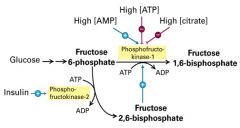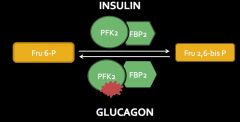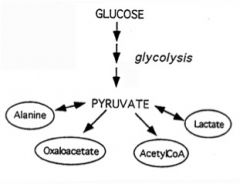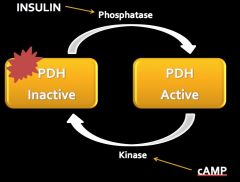![]()
![]()
![]()
Use LEFT and RIGHT arrow keys to navigate between flashcards;
Use UP and DOWN arrow keys to flip the card;
H to show hint;
A reads text to speech;
30 Cards in this Set
- Front
- Back
|
Where does glycolysis occur? What is the overall reaction? What other major products are formed?
|
Cytosol of all tissues
Glucose-->2 pyruvate Produces NADH and ATP |
|
|
What is the first step of glycolysis? What enzymes regulate this step? How are these enzymes regulated?
|
Glucose --> Glucose 6-Phosphate
Regulated by: Hexokinase - feedback inhibition by G6P Glucokinase: only in liver and beta-cells!! Insulin increases activity and content; decreased activity by counterregulatory hormones |
|
|
How do glucokinase and hexokinase differ in Vmax and Km in relation to blood glucose concentration?
|
Hexokinase: Low Km, Low Vmax
Glucokinase (liver): High Km, High Vm; directly regulated by blood glucose |
|
|
What is the second step in glycolysis?
|
Glucose-6 Phosphate --> Fructose-6-Phosphate
|
|
|
What is the third step in glycolysis? What enzyme performs this? How is this enzyme regulated?
Describe any interactions with other enzymes. |

Fructose-6-Phosphate-->Fructose 1,6-bisphosphate
Phosphofructokinase-1 (PFK-1) Increased activity when High AMP, High Fructose 2,6-bisphosphate Decreased activity when High ATP and High Citrate Fructose 2,6-bisphosphate obtained via: Fructose 6-phosphate --> Fructose 2,6-Phosphate Reaction; catalyzed by PFK-2 PFK-2 activity increased with High INSULIN. |
|
|
What are the energy investment steps of glycolysis?
|
Steps involving phosphorylation:
Glucose --> Glucose 6-Phosphate (hexokinase and glucokinase) Fructose 6-phosphate --> Fructose 1,6-bisphosphate (PFK-1) |
|
|
What are the effects of insulin and glucagon on concentrations of 2,6-bisphosphate? How is this effect mediated?
|

Insulin activates PFK2 via dephorphorylation; thus reaction is driven so that:
Fru 6-P-->Fru 2,6-bisphosphate When glucagon is present, PFK2 is phosphorylated and deactivated; thus, driving reaction so that: Fru 2,6-bis P --> Fru 6-P This dephosphorylation is achieved via a phosphatase present in association with PFK2. Phosphatase = FBP2 |
|
|
What is the last step of glycolysis? What enzyme catalyzes this reaction? How is this enzyme regulated?
|
Phosphoenolpyruvate-->Pyruvate
via Pyruvate Kinase Inhibited by ATP (allosterics); inactived by glucagon and epinephrine Activated by insulin |
|
|
How does glycolysis differ in aerobic and anaerobic conditions? What products are formed by each reaction (other than glucose)?
|
Aerobic:
Pyruvate enters mitochondria, converted into AcetylCoA for TCA NADH drives production of ATP via oxidative phosphorylation Anaerobic: Pyruvate reduced to lactate and NADH reconverted to NAD+ Lactate goes to liver to form glucose. Glucose returns to muscle. |
|
|
What is the Cori Cycle?
|
Under anaerobic conditions:
Glucose-->Lactate in Muscle Lactate travels to Liver Lactate-->Glucose in Liver Glucose-->Blood-->Liver |
|
|
What are the clinical manifestations of pyruvate kinase deficiency?
|
This enzyme is crucial for last step of glycolysis (formation of pyruvate). RBC's require this enzyme to make ATP, maintain membrane transporters, and maintain shape
Without this enzyme, shape cannot be maintained, and RBCs develop spikes, and lose flexibility. Results in hemolytic anemia and jaundice. |
|
|
Why is pyruvate considered a metabolic junction?
|

Has various fates:
Alanine (amino acid/carbohydrate metabolism) Oxaloacetate (gluconeogenesis) AcetylCoA (TCA cycle) Lactate (Anaerobic metabolism) |
|
|
Where does pyruvate oxidation occur? What are the reactants and products of this reaction?
What enzyme catalyzes this reaction? How is it regulated? |
Occurs in mitochondrial matrix
Pyruvate + CoA-SH + NAD+-->Acetyl-CoA + CO2 Catalyzed by Pyruvate Dehydrogenase, which is inhibited by Ac-CoA and NADH; regulated by phosphorylation |
|
|
What is the effect of insulin on pyruvate dehydrogenase? How is this effect mediated?
How is it counteracted? |

Insulin dephosphorylates inactive PDH via phosphatase; cAMP activates kinase which phosphorylates active PDH into inactive PDH
|
|
|
What does the PDH complex require (to function)?
|
Pyrophosphates (B, thiamine)
FAD (B2, riboflavin) NAD (B3, niacin) CoA (B4, pantothenate) Lipoic Acid |
|
|
Where does the Citric Acid Cycle occur? What function does it serve?
What are its reactants and products? |
Mitochondrial Matrix
Energy transfer from acetyl-CoA to high energy compounds that drive ATP production; intermediates go to other biosynthetic pathways Acetyl-CoA-->3 NADH, FADH2, GTP, 2CO2 (=12 ATP per acetyl-CoA) |
|
|
Briefly describe the steps of the Citric Acid Cycle.
|
Acetyl-CoA donates 2C acetyl group to 4C oxaloacetate
Lots of oxidation reactions Oxaloacetate regenerated |
|
|
How are the rates of glycolysis and TCA cycle integrated?
|
Rate of Pyruvate to Acetyl CoA integrated
Allosteric inhibition by ATP & NADH Citrate inhibits PFK-1 |
|
|
What enzymes in TCA are regulated?
Which is the pacemaker? |
First three steps of TCA:
Acetyl-CoA+OAA-->Citrate Citrate-->Isocitrate Isocitrate-->alpha-ketoglutarate Citrate Synthase Isocitrate DH ("pacemaker") A-keoglutarate DH |
|
|
What is the purpose of gluconeogenesis and where does it occur?
What is its ultimate product? What substrates are required (other than those involved in bypass reactions)? |
Production of glucose to maintain availability for glucose-requiring tissues (required for lengthy fasting)
Occurs in LIVER cytosol and mitochondria Lactate + Glycerol + Glucogenic AA's-->Glucose |
|
|
What tissues in the body require glucose?
|
Brain & NA
Erythrocytes Testes Renal Medulla Embryonic Tissues |
|
|
What are the reactions of gluconeogenesis? What do they bypass?
|
Pyruvate-->OAA (via Pyruvate Carboxylase)
OAA-->PEP (via PEP Carboxykinase) Fru 1,6-bis P-->Fru6-P (via Fru1,6-bisphosphatase) G6P-->Glucose (via Glucose 6-phosphatase) Gluconeogenesis is like glycolysis in reverse, so must bypass irreversible glycolytic reactions |
|
|
How are gluconeogenesis and glycolysis reciprocally regulated?
Explain effect of: F-2,6-BP AMP ATP Citrate H+ On Phosphofructokinase and Fructose 1,6-bisphosphatase activity |
PFK:
F-2,6-BP + AMP + ATP - Citrate - H+ - Fructose 1,6-bisphosphatase: F-2,6-BP - AMP - Citrate + |
|
|
How are gluconeogenesis and glycolysis reciprocally regulated?
Explain effect of: F-1,6-BP ADP ATP Alanine AcetylCoA On Pyruvate Kinase, Phosphoenolpyruvate Carboxykinase, and Pyruvate Carboxylase. |
Pyruvate Kinase:
F-1,6-BP + ATP - Alanine - Phophoenolpyruvate Carboxykinase: ADP - Pyruvate carboxylase: AcetylCoA + ADP - |
|
|
How much energy does gluconeogenesis require? List numbers of molecules.
Can fat be used to substitute this energy? |
4 ATP, 2 GTP, 2NADH: A LOT OF ENERGY!
No, AcetylCoA (fat) is not a substrate |
|
|
What are the regulatory enzymes of gluconeogenesis?
|
Pyruvate Kinase; PFK-2/FBP-2
|
|
|
What is the effect of insulin on glycolysis? On gluconeogenesis?
|
Fed State = Insulin!
Accelerates Glycolysis Suppresses Gluconeogenesis All via protein kinase cascade |
|
|
What is the effect of glucagon on glycolysis? On gluconeogenesis?
What is the net result of glucagon? |
Blocks glycolysis
Stimulates gluconeogenesis Net result is release of liver glucose cAMP mediated |
|
|
What is the effect of DM on liver glucose metabolism?
|
Insufficient insulin and excess glucagon-->high blood glucose, decreased glycolysis, increased gluconeogenesis
|
|
|
Contrast actions of following enzymes:
Pyruvate Dehydrogenase Pyruvate Kinase Pyruvate Carboxylase |
Pyruvate DH: Pyruvate-->AcCoa
Pyruvate Kinase: PEP-->Pyruvate Pyruvate Carboxylase: Pyruvate-->OAA |

